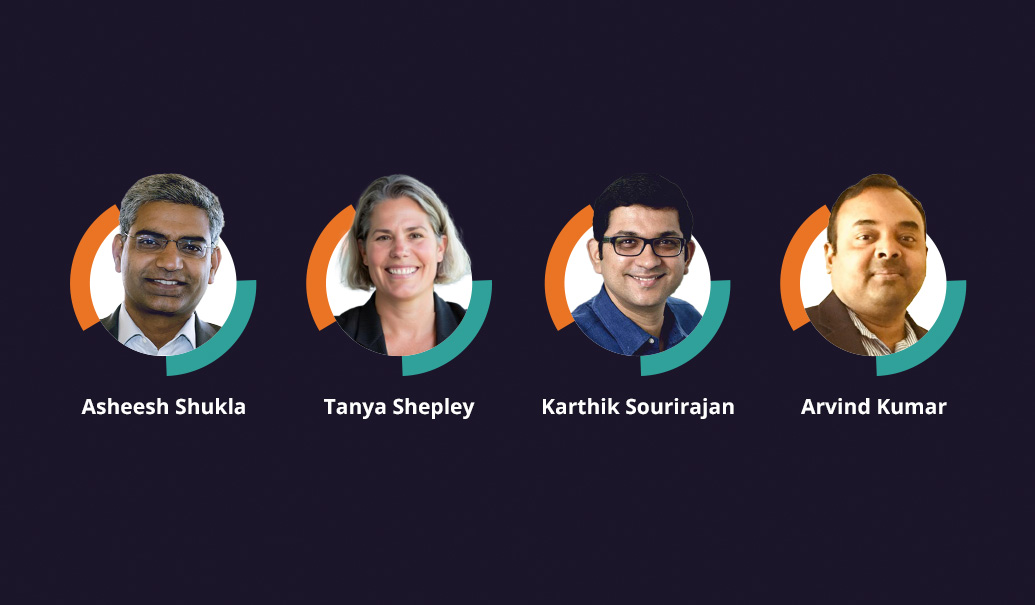How life sciences businesses, payers and providers can thrive through the 21st-century healthcare system by better serving patients emerged as a central theme of this year’s ZS Impact Summit.
“We’ve just come through one of the biggest disruptions in healthcare, the biggest in the century perhaps,” said Pratap Khedkar, CEO at ZS. “It was uncomfortable for us. It was challenging. It is probably still challenging in many ways.”
“And it brought changes to how healthcare was delivered, how it was consumed,” he added, “but it also created the opportunity to do things differently and do them better.”
Khedkar was joined at the Sept. 21 event by leaders from across the healthcare spectrum who shared lessons learned from current initiatives and thoughts on where the industry is headed. Dr. Sanjay Gupta, a neurosurgeon and CNN’s chief medical correspondent, and Dr. Toby Cosgrove, executive advisor and former CEO at the Cleveland Clinic, gave keynote talks.
Here’s a look at some of the key discussions.
Life sciences organizations must look outside of themselves for success
In his opening session address, Khedkar challenged life sciences organizations to step in and play a meaningful role in helping the healthcare ecosystem eliminate disparities in access to care.
“Your ZIP code is the biggest predictor of your health—bigger than your genetic code. That screams against every instinct that we have, that health should be all about biology. Working toward equity is something we can all agree on. Healthcare entities are working on this, but they aren’t going to solve it on their own. They need to partner, they need to collaborate,” said Khedkar, underlining one of the major themes of this year’s Impact Summit.
Examples of life sciences companies that have answered this challenge include Novartis, which committed to addressing racial disparities in breast cancer screening, treatment and care. According to Khedkar, one of the primary ways pharma can bring value to this conversation is by engaging closely with the other players in the healthcare ecosystem—that is, taking a business-to-ecosystem approach. Fortunately, the door to opportunity is open.
According to a ZS survey, two-thirds of healthcare executives are open to collaborating with pharma as a result of the events of the past year and a half, Khedkar said. To succeed in these collaborations, life sciences organizations need to understand how other players in the healthcare ecosystem are interacting with each other.
“Not just bilaterally with pharma but multilaterally with each other. Because I think entering their equation around the patient is more valuable than trying to create a bilateral relationship only. So it’s a bit of a mindset shift and I think we need to be there,” said Khedkar.
The future of healthcare is interconnected
In an expansive keynote conversation, Gupta and ZS principal Maria Whitman discussed the need for greater agility, clarity, collaboration and patient-centricity in healthcare delivery.
“I don’t want to say anything’s preordained, but I think that has to happen,” Gupta said. “I think it’s a question of how well does it all come together—and how quickly?”
“I think there are probably some cardinal rules here: A really connected ecosystem … requires clear vision on interoperability, and it’s got to be very transparent,” he added. “All the players have to have good transparency and good vision on how they’re operating with all those other players in the ecosystem.”
How to create the underlying global interoperability, Gupta said, is the “biggest challenge.” Just as healthcare systems vary by country, so do procedures around data collection and the mushrooming amount of data from wearable devices.
He and Whitman discussed the need for open dialogue as life sciences organizations define their role in the healthcare ecosystem and identify new ways to work together. Learnings from major health crises such as COVID-19 are more likely to stick when health equity can be addressed and care can shift to become more preventative. “So much of this was preventable,” Gupta said. “The virus was not.”
“Each of (the) stakeholders is looking ahead saying, ‘What is my new role? What is my new value?’” Whitman said. “If you know where everybody’s heading, then the agility point you’re making might become easier because we can know where the pivots are needed … to keep moving in a direction as the world changes.”
Cosgrove predicts approaching the ‘golden age’ of healthcare
During an Impact Summit general session conversation about the intersection of technology and healthcare, former Cleveland Clinic CEO Toby Cosgrove told ZS principal Hensley Evans that the U.S. is on the verge of the “golden age of healthcare” thanks to unprecedented collaboration among healthcare stakeholders in response to the pandemic.
COVID-19 not only forced providers and vendors to scale telehealth practically overnight, but it also highlighted glaring racial and economic disparities in outcomes and access to care. The demand for vaccines also gave way to unprecedented collaboration between pharmaceutical companies.
“Companies that are developing the most effective approaches are doing it in partnership with each other. They’re not doing it in silos,” said Evans.
She added that leadership, in the future, will require partnering effectively with a wide range of organizations and structures, including technology companies. Cosgrove agreed, noting that providers are dependent upon several industries as well, including tech and pharma.
“The better that we can work together, both in helping development and understanding each other’s needs, the faster we’re going to go forward. One of the reasons that I was interested in working with Google as a consultant was, I know that the healthcare industry didn’t understand the tech [industry] very well. And I was pretty sure that tech didn’t understand healthcare very well. And I hope to try and bring those two understandings together so we each understand the other’s problems and we could collaborate in a stronger way,” said Cosgrove.
Another key focus of the conversation between Cosgrove and Evans was the explosion of data now available to pharma companies and other researchers, thanks to collaborations between medical record vendors like Epic and artificial intelligence (AI) companies such as DeepMind, a subsidiary of Google.
Cosgrove and Evans agreed that the massive data sets held by tech companies are of enormous value for medical and pharmaceutical research.
“You always used to have to go to the FDA with prospective randomized trials, which were very time-consuming, very expensive and slow, and they didn’t wind up necessarily giving you a true picture of the population. Now, using real-world data, you can do it faster. And by the way, it’s now possible to use AI to begin to identify where these patients are, which makes it a lot easier for pharmaceutical companies to do their trials,” said Cosgrove.
Life sciences companies should look to collaborate
Khedkar also helmed a discussion, “Amplifying value through ecosystem collaboration,” which featured panelists from three players in the healthcare ecosystem that are each focused on helping patients managing chronic conditions, primarily through mobile technologies.
Amit Shah, chief clinical operations officer for Virta Health, explained that his startup is the first and largest virtual clinic devoted to reversing diabetes and keeping patients off medications by using remote care platforms.
“It’s really difficult to drive the type of change that we want to drive in healthcare without getting a lot of collaborators, stakeholders involved…. The business model for Virta is to work with self-insured employer groups and payers. And so that is one subset of customers, and we need to collaborate with them and understand what their needs are,” said Shah.
Khedkar asked panelists for their perspectives on how well life sciences companies are stepping in to add value in the healthcare ecosystem.
Karen Martell, VP and general manager of endocrinology for Alto Pharmacy, said she doesn’t see life sciences organizations moving as quickly—or as nimbly—as they could. For many years they’ve focused on sales and revenue and spent less time on market access, which is also where Alto operates.
“And I know so many have given their whole lives inventing these amazing drugs, and I think there are more tools at your fingertips to get them in the hands of patients and drive the outcomes that many dreamed of decades ago,” said Martell.
Virta’s Shah agreed with Martell.
“We often feel like if you’re not going to disrupt yourself, you will get disrupted. And so looking at these new care models and saying, ‘How do we engage with the care model like Virta’s? How do we engage with a partner like Alto? How do we engage to meet patients where they are?’”
Thinking digitally leverages real-world evidence to redefine care
In his session, ZS principal Brian Chapman led a discussion of how digital health innovations will advance diagnostic capabilities and make treatment procedures more reproducible. For example:
- Innovations in AI and deep-learning tools can bring precision and consistency to identifying cardiopulmonary conditions.
- Next-generation sequencing promises early cancer detection.
- Managing medtech data sets through AI models can help providers determine appropriate therapies and guide patients through treatment and recovery—all while driving down cost through efficiency gains.
The connective tissue? For Sharrolyn Josse, the worldwide president of VELYS Digital Surgery and Capital at Johnson & Johnson’s DePuy Synthes unit, it was creating learning systems and thinking more broadly.
“We need to think more horizontally across the procedure—and what are those other elements,” she said. “What’s really important, too, is that you don’t just think about those elements as individual components … you’re now thinking about how do you actually pull together these data sets and data points and make them work together seamlessly.”
Connor Landgraf, co-founder and CEO at Eko, agreed: “Find ways to really get some sort of business-model connection to your digital strategy so that you’re able to really demonstrate that this isn’t just an additive, bonus feature.”
“It’s not just the companion app to the product,” he added, “but it really is integral to the product … so that the product and the digital experience can’t exist without each other.”
ZS unveils ZAIDYN™ artificial-intelligence-driven platform
While many of the day’s sessions focused on how the future is becoming more digital, ZS COO Sandra Forero and managing principal and platform lead at ZS Sanjay Joshi shared how we’re helping companies achieve this. They announced the launch of ZAIDYN™ by ZS, a platform that life sciences companies can use to digitally transform and scale customer engagement, field performance, analytics and clinical capabilities. The platform integrates with clients’ existing technology environments via an open, modular, cloud-based architecture that features business-ready connectors to third-party data sources, business apps and enterprise systems. “It connects well with IT systems, resulting in easier integration, lower cost of operations and global scale. As a life sciences AI platform, ZAIDYN™ gets smarter over time and increases in value for our clients,” said Joshi. Visit the platform’s landing page for more details.
The future begins today
ZS principals Hensley Evans and Malcolm Sturgis left attendees of the Impact Summit with their parting thoughts on three ways life sciences companies can adapt to an evolving marketplace and prepare for what’s next.
“I like alliteration, so we’ll call them ‘mindset,’ ‘metric’ and ‘method.’ The mindset is probably the most important part. This is about shifting our overall culture toward a broader business-to-ecosystem approach,” Evans said.
“The metrics are also critical. As more players enter the ecosystem, there will be more potentially conflicting objectives. Find a common objective that you can align to and work on together, and patient outcomes is a great place to start,” she added. “Last but not least: Method. For example, consider how effective it can be to subsegment the community into smaller, more manageable pieces.”
Add insights to your inbox
We’ll send you content you’ll want to read – and put to use.














